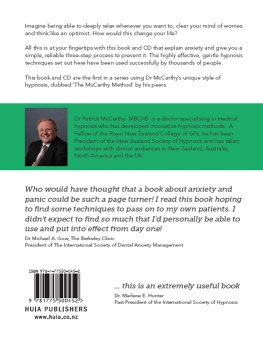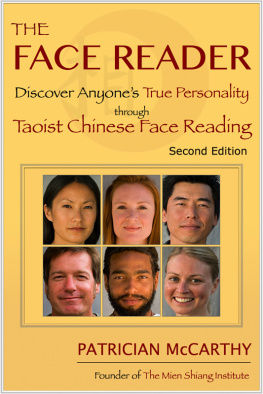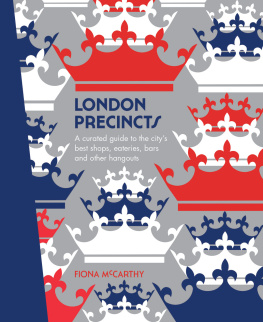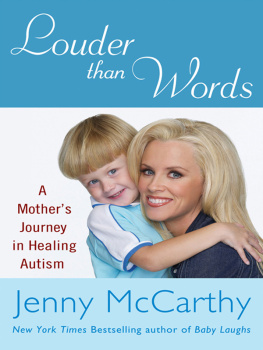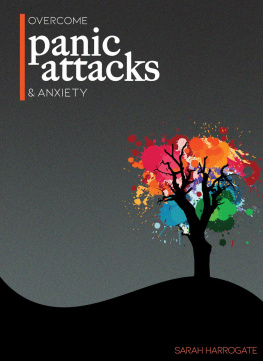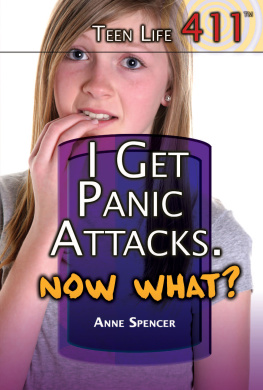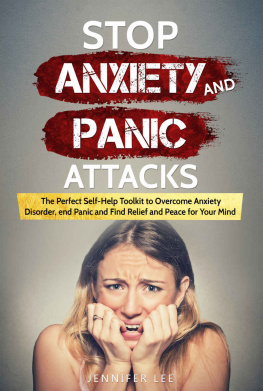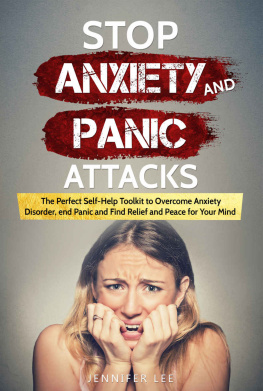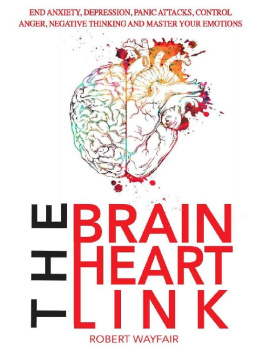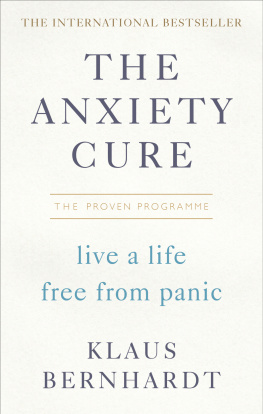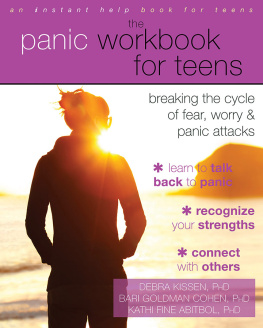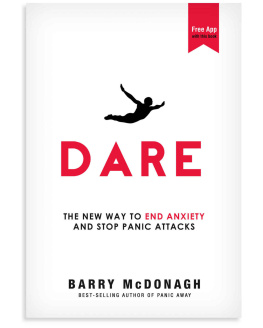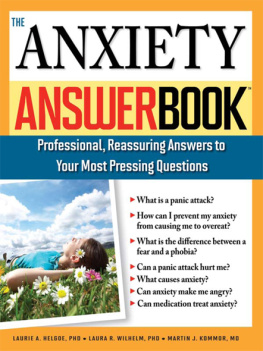First published in 2012 by Huia Publishers
39 Pipitea Street, PO Box 17335
Wellington, Aotearoa New Zealand
www.huia.co.nz
ISBN 978-1-77550-045-2 (print)
ISBN 978-1-77550-064-3 (epub)
ISBN 978-1-77550-065-0 (mobi)
Copyright Patrick McCarthy 2012
Illustrations: Scott Pearson
Cover design: Gillian McCarthy
Ebook production 2012 by meBooks
This book is copyright. Apart from fair dealing for the purpose of private study, research, criticism or review, as permitted under the Copyright Act, no part may be reproduced by any process without the prior permission of the publisher.
National Library of New Zealand Cataloguing-in-Publication Data
McCarthy, Patrick, Dr.
Relax : say goodbye to anxiety and panic / Patrick McCarthy.
ISBN 978-1-77550-045-2
1. AnxietyTreatment. 1. Autogenic training. I. Title.
618.8522065122dc 23
This book is dedicated to my wife, Celia.
We have been married for over 30 years and she has always been my inspiration, my strength and my rock. She is the most remarkable person I have ever met.
Preface
As a busy general practitioner in Scotland in the early 1980s I was struck by the increasing number of people presenting at my surgery with distressing symptoms suggestive of anxiety and panic attacks. I routinely prescribed medication to them. I seldom do so now.
In 1991, 11 years after graduating in medicine from Glasgow University, I trained in clinical hypnosis. Five years later, I opened the first and still the only Medical Hypnosis practice in New Zealand. Since then I have successfully treated thousands of people with anxiety or panic. People have travelled to my rooms in central Wellington for anxiety treatment from all over New Zealand based on word-of-mouth recommendation or referral from their own doctor.
My peers worldwide respect the unique style and delivery of hypnosis that I have developed, and I have been invited as keynote speaker to dozens of hypnosis conferences in New Zealand, Australia, the US, Canada and the UK over the past 20 years. However, this is the first time that this innovative method of treating anxiety appears in print. Its publication is the result of my patients and professional colleagues urging me to share these skills with a wider audience.
This book outlines my understanding of the causes, the mechanisms and the ways to address and deal with anxiety and panic. The book represents the introductory session I have with a patient. The MP3s contains the three treatment sessions that follow. The accompanying MP3s augment the writing and teaches these methods to abolish anxiety, including safe self-hypnosis that is easy to learn. Together the book and MP3s will give you a clear pathway to understanding how to cure anxiety and panic.
If you are prone to anxiety or panic attacks then there are three key skills that you need to learn. They are all contained here. You will not need to travel to Wellington or to New Zealand nor spend hundreds of dollars to receive individual therapy over several weeks or months. You can enjoy listening to the contents of the MP3s in the comfort of your own home.
I wish you all the very best for your relaxed life to be.


Chapter one
Turning Anxiety into Relaxation:
The Relaxation Attack
My heart was thumping. It felt like my ribs could explode at any moment. My chest felt tighter and tighter. It was becoming harder and harder to breathe. A band of tension spread over my forehead and temples. Sweat trickled down my back and my palms were clammy. My mind kept racing from one image to another and I was filled with dread in the pit of my stomach. I knew that I had no real problems of any great significance in any aspect of my life. So why was I feeling this way? Was I going mad?
Five minutes earlier I had been completely normal. I had been sitting down and simply reading the newspaper. These sudden and dramatic changes in my mind and body had erupted like a volcano, apparently from nowhere.
I felt hopeless and helpless. There was nothing that I could do. I realised that I was breathing too quickly. I tried to slow my breathing but failed. Nothing changed. I was gripped with fear, fighting the escalating thoughts that these sensations might be the signs of a heart attack.
This was not the first time that I had felt these horrible symptoms. I knew that they probably did not indicate a heart attack but were evidence of yet another anxiety attack. I had been having episodes like this almost every day for the last three months. The first three times I had called for an ambulance and been rushed to the nearest hospital. The emergency room doctors had checked me out, listened to my heart and given me an ECG. They told me there was nothing wrong with me, that my heart was completely normal.
Nothing wrong: really? This was nothing wrong?!
The man whose story this is, Tommy, was a successful young businessman in his early 30s. Living in Wellington, he was happily married to Grace. They had two healthy, delightful young daughters.
Tommy was desperate, and he is not the only one to feel this way. I have heard similar descriptions of anxiety and panic from the many patients that I treat. The stories that they tell me vary only in their intensity and their frequency.
A Basic Biological Fact
For over 20 years I have been successfully treating those who suffer from anxiety and panic, by teaching them how to use a unique combination of Medical Hypnosis techniques that most people can easily and quickly learn.
My method starts from a very simple fact about how the human body functions.
In order to become anxious or to panic, we need a nervous system. Plants do not have a nervous system. You cannot scare a bush or a tree or a field of grass. Plants do not get anxious. Bushes, trees and fields of grass do not run away in fear.
Animals do have nervous systems and they can be frightened. You know that you can scare a cat or a dog or a mouse or a horse or a human being. But were you aware that we human beings have two nervous systems?
If this is new information to you, then please be aware that you are not the only one. The vast majority of my patients are surprised to learn this basic physiological fact about the human body: we have a central nervous system and an autonomic nervous system.
Our central nervous system controls our voluntary activity. If I want to lift my right hand up, move it down, thrust it out, or bring it in, then I use my central nervous system. I also use my central nervous system to speak and to listen. You are using your central nervous system to speak, to read and to process and understand these written words.
Our autonomic nervous system, on the other hand, controls our automatic and involuntary bodily activities. It:
controls the rise and fall of our heart rate;
puts our blood pressure up or down;
dilates or constricts our pupils;
increases or decreases the blood flow to our skin;
tightens or loosens our muscles;
speeds up or slows down our breathing.
The Autonomic Nervous System
The autonomic nervous system controls many of our bodys daily activities. We do not have to think for an instant about how much blood to send to each of our toes. We do not have to choose to breathe and to keep breathing 24 hours a day. Our autonomic nervous system meets these requirements and many more, automatically and constantly. In fact the vast majority of body responses are controlled and regulated by the autonomic nervous system. You may therefore wish to think of it as being like an amazing autopilot that monitors, regulates and alters functions in every part of the body at all times.

